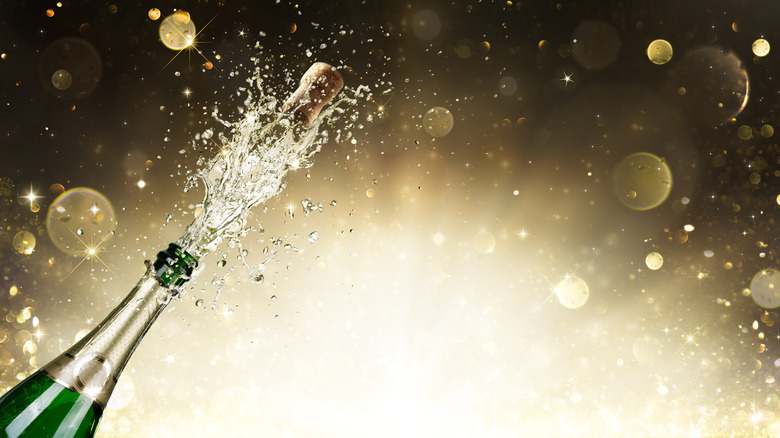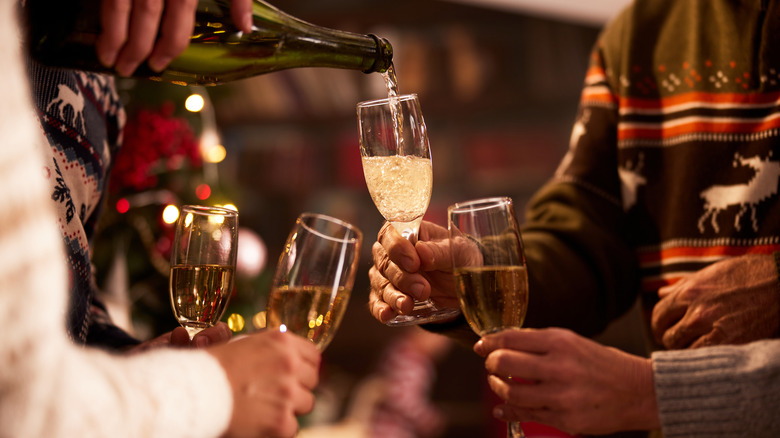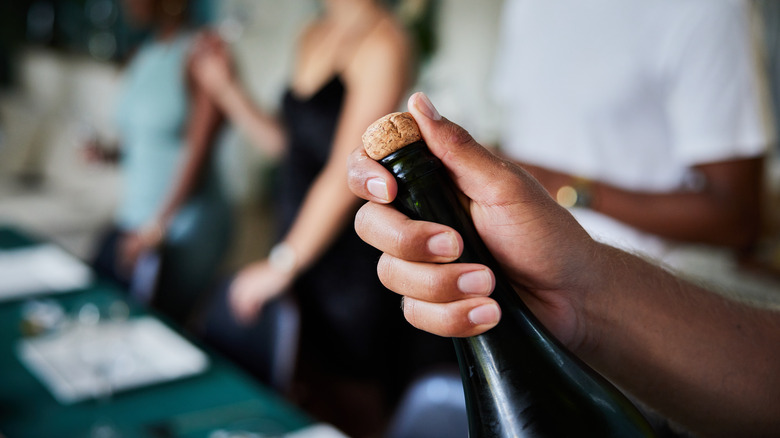Why We Pop Bottles Of Champagne To Ring In The New Year
The countdown has begun. The ball is about to drop. Midnight on New Year's is about to strike, and there's nothing left to do but grab a bottle of bubbly and time that cork pop to happen just as Auld Lang Syne is about to strike up. It's a time-honored tradition that we look forward to every year, but when did popping champagne become so synonymous with having a happy new year? Like many old holiday traditions, the origins aren't the easiest to trace exactly, but many believe that the practice's popularity may have started as far back as 1881! Now there's some aged champagne!
No matter where or when it started, or what type of bubbly you've got a bottle of, the act of popping champagne to usher in the ensuing year is a tradition we hold dear. There's not just one reason that led to its widespread ever-presence around the holidays, there happen to be a few instances throughout history that we have to thank for giving us the gift of cork popping every year. Let's find out a little more about the origin behind this celebratory act before the holidays are here and we have to wait a whole 365 days to discuss it again!
Champagne's popularity was enforced by a restaurant
Champagne was first popularized after it replaced wassail as the customary beverage with which to toast the new year. Records from 1881 reveal that the increased use of champagne at festive gatherings was a new trend and becoming more common around this time. Overseas, the bubbly stuff was already commonplace around social gatherings, most notably in France. There, champagne, which was popularized by the aptly named Benedictine monk Dom Perignon, was used not only at celebrations but to raise a glass in honor of occasions such as coronations and the signing of important treaties. Champagne was everywhere, so it was only a matter of time before it was used to toast the coming of a new year.
As far as the United States is concerned, one might attribute the popularity of champagne-popping revelry to a popular New York restaurant's 1937 New Year's Eve party. Cafe Martin's, the eatery in question, was high on the list of desirable places for high-society members to dine. This particular New Year's Eve, guests could order anything they wanted to eat, so long as champagne was part of the order. Luckily for the guests, the cafe offered a whopping list of 200 types of champagne, so variety was no matter. Furthermore, the restaurant was said to serve only champagne after 9 p.m. on New Year's Eve, which would make it the only thing around to pop once midnight rolled around. Thus, a New Year's tradition was born!
New Year's Eve might be the world's drunkest night
While champagne is something that is enjoyed all year round, once special occasions arise, New Year's Eve is understandably the most popular night for it. There are 360 million glasses of champagne consumed every New Year's Eve (which doesn't even begin to account for the other libations consumed by those who pass on the bubbly stuff!) Often referred to as the world's drunkest night, research has shown that might not necessarily be true. Though there is lots to knock back as the ball is dropping, a report from Bactrack regarding breathalyzer tests on holidays showed that New Year's Eve is actually tied with Saint Patrick's Day at an average of .094% blood alcohol content for revelers. While one day may not necessarily be more inebriated than the other, let's all agree to call cabs on those days!
So, the next time you're at a New Year's party, and that hallowed hour of midnight is rapidly approaching, rest assured that the cork you're readying to rocket off into the night is part of a time-honored tradition. Pour a glass, kiss a loved one, and enjoy the ushering in of a fresh, new January full of possibilities ... that is, until that hangover kicks in the next morning!


